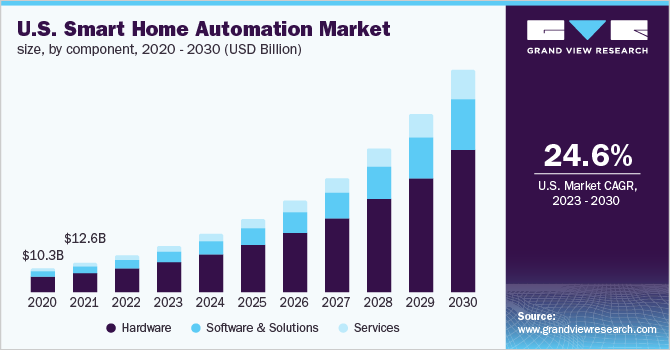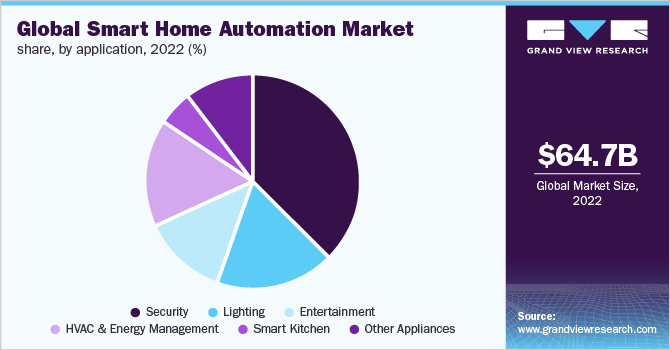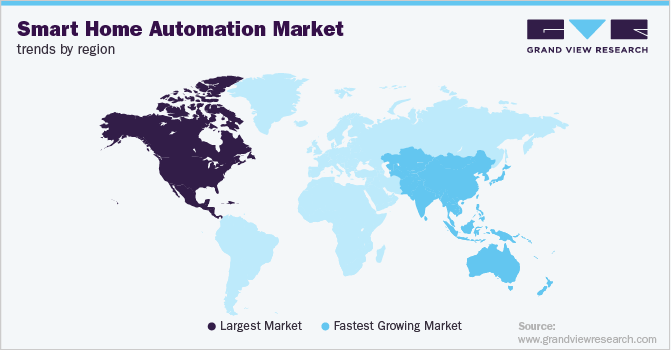- Home
- »
- Next Generation Technologies
- »
-
Global Smart Home Automation Market Size Report, 2030GVR Report cover
![Smart Home Automation Market Size, Share & Trends Report]()
Smart Home Automation Market Size, Share & Trends Analysis Report By Component (Hardware, Software, Service), By Technology, By Application, By Fitment, By Region, And Segment Forecasts, 2023 - 2030
- Report ID: GVR-1-68038-880-0
- Number of Report Pages: 163
- Format: PDF, Horizon Databook
- Historical Range: 2018 - 2021
- Forecast Period: 2023 - 2030
- Industry: Technology
Report Overview
The global smart home automation market size was valued at USD 64.66 billion in 2022 and is predicted to expand at a compound annual growth rate (CAGR) of 27.3% from 2023 to 2030. The increasing demand from consumers for features such as remote location operation and interactive experiences offered by smart home automation is expected to propel the global market growth. In addition, the rising trend for smart assistants is expected to drive the growth of the market. For instance, in January 2023, Apple, Inc. launched its second-generation HomePod with features and sensors that support home automation.

The opportunities for advancements in smart home automation systems using mobile applications and platforms such as central hubs and voice-enabled assistants, among others, are expected to be significant, as mobile applications offer consumers a central hub and automation access for all connected devices. For instance, Samsung Electronics Co., Ltd.’s SmartThings is a home automation application that connects the company’s smart products such as smart refrigerators and smart washing machines. Similarly, LG Electronics operates its own smart automation application called LG ThinQ, which is compatible with Android and iOS devices.
The rise in internet accessibility and penetration, which enables connectivity between objects and devices in a home, allowing users to remotely monitor and control them, has increased the market demand in urban areas. For instance, in January 2022, India had 336.60 million internet subscribers in urban areas, according to a report by the Telecom Regulatory Authority of India (TRAI). Further, the growing presence of the Internet of Things (IoT) system, which offers device-to-device communication and control, all together providing an interactive environment with enhanced convenience, has increased the adoption of smart home automation technology. For instance, the number of connected IoT devices was around 14.4 billion in 2022, according to a report by IoT Analytics. The number of connected IoT devices is expected to reach up to 27 billion by 2025.
Furthermore, the global home automation market growth has accelerated due to the rising awareness of home automation technology and the growing trend for luxurious lifestyle patterns. The increased demand for smart applications such as voice control, energy management, and others has created lucrative business opportunities in the market. Smart home automation offers convenience and efficiency in daily tasks to users in the residential sector. Furthermore, advancements in technology have allowed residential automation systems to connect and control multiple devices around the clock, thereby enhancing overall user comfort.
Moreover, smart home automation manufacturers are focusing on attracting customers by creating affordable products and pricing them competitively. Companies are acquiring smaller startups to increase their product portfolio. Furthermore, in order to gain a competitive edge in the market, key players are focusing on providing exclusive technology and feature-rich solutions. For instance, in September 2022, Goove launched its LED Strip Light M1, a smart LED light, which offers music sync, customizable colors, and smart assistant support, among other features.
Component Insights
The hardware component accounted for the highest market share in 2022 and is expected to dominate the market till 2030. The segment growth is attributed to the demand for home automation hardware such as lighting control, security & access control, smoke detectors, and more. The hardware offered by companies provides its users with several advantages such as minimized size, portability, wireless operation using batteries, and wireless connectivity, among others, all of which add to the user's comfort and convenience. For instance, in November 2022, Signify N.V. launched two portable smart lights in India. The smart lights launched were sensor-equipped and offered application support for home automation.
The services component segment is predicted to expand at the highest CAGR over the forecast period from 2023 to 2030 due to the trend of homeowners hiring home automation service providers for the installation and maintenance of smart home products or automation systems. Further, service subscription companies offer trained technicians to coordinate with homeowners, which provides consumers with ease of installation, maintenance, and repair of home automated systems. For instance, Control4 Corporation’s smart home pro service sends a technician to assist homeowners with their home automation systems.
Application Insights
The smart kitchen segment is predicted to attain the highest CAGR in the forecast period from 2023 to 2030 due to the proliferation of automated kitchen products, as it offers convenience for cooking applications. For instance, in January 2023, General Electric Company revealed its Profile smart mixer which was integrated with voice assistant support and connectivity support. Additionally, the launch of new smart refrigerators has contributed to the segment's growth. For instance, in January 2023, LG Electronics announced its smart MoodUP refrigerator which featured a LED panel, Wi-Fi connectivity, Bluetooth connectivity, and other smart features.

The security & access application segment accounted for the largest market revenue share in 2022 and is expected to dominate the market till 2030. The rising demand for security and access control automation systems for safeguarding homeowners’ valuable possessions is a driving factor for the segment. To cater to this demand, companies provide automation systems with advanced security features such as biometric verification, passcode entry, motion detection, and more, either as a one-time solution or a subscription-based solution. For instance, Amazon.com, Inc.’s Ring LLC offers security & access solutions in its portfolio for home applications.
Technology Insights
The wireless technology segment is expected to expand at the highest CAGR over the forecast period of 2023 to 2030. This strong growth is attributed to the capabilities and features of mobile connectivity through network protocols such as ZigBee, Wi-Fi, Bluetooth, Z Wave, and others. Manufacturers prefer protocols that offer smooth communication, with less to no impact on battery life and range. For instance, the ZigBee protocol provides longer battery life as it operates on lower latency and a low-duty cycle for instant device-to-device communication.
The hybrid technology segment recorded the highest market revenue share in 2022 due to the benefit of long-range connectivity provided by the combination of wireless and wired technologies. The demand for this segment is driven by homeowners with complex home layouts, as devices can be connected despite wall placement, room location, and other structural factors. Additionally, the downtime in hybrid technology is less as a result of dual modes of connectivity. For instance, if there is a failure in a wired cable, the device can still communicate via its wireless capability.
Fitment Insights
The retrofit fitment segment recorded the highest market revenue share in 2022 and is expected to dominate the market till 2030. The segment’s growth is attributed to the high number of already constructed homes. For instance, in 2021, there were around 2.3 billion homes in the world, according to a finding by Architecture & Design. The rise in connectivity and internet penetration in developing regions is a major contributing factor toward the high demand for retrofit fitments.
The new construction fitment segment is expected to attain the highest CAGR during the forecast period from 2023 to 2030. This growth is a result of new home construction projects undertaken by construction companies to cater to the demand for smart homes by the growing population globally. Moreover, the installation of automated systems is easier in new constructions due to the prior knowledge of wall placements, rooms, and other structural components. The growing trend of customized smart home automation systems based on consumer requirements is also a driver for this segment.
Regional Insights
North America recorded the highest revenue share of the market in 2022. The growing popularity of smart home products and automation systems in the U.S. is significantly driving regional market expansion. The U.S. holds a significant share of the North American smart home automation market due to the presence of legacy companies, the emergence of new players, and the high penetration of connectivity technologies in the country.

Asia Pacific is expected to expand at the highest CAGR over the forecast period from 2023 to 2030. The regional growth can be attributed to the healthy rise in disposable income owing to macroeconomic stimulus. Innovative technologies, such as voice-controlled smart home devices, and rising internet penetration which facilitates connected home automation, are driving the market growth in this region. Moreover, Asian economies such as China are home to large manufacturing hubs for home automation sensors and IoT devices, which further drives market growth.
Key Companies & Market Share Insights
The key players in the market are using strategies such as joint ventures, collaborations, innovations, research and development, and geographical expansions to grow and consolidate their market position. Companies are also focusing on developing and updating their product offerings to better suit the changing needs of users for staying competitive. Smart home automation providers are concentrating on finding partnership opportunities with software developers or hardware companies to add to their existing home automation portfolio. For instance, in December 2022, Schneider Electric partnered with Smartworld Developers Pvt. Ltd. to develop 360-degree home automation systems.
Leading market players are introducing new products with competitive pricing and different features to cater to a range of customers. Constant research and development activities are leading to the industry becoming more standardized. Due to globalization, the smart home automation trend is present in countries worldwide. The prominent players in the global smart home automation market are:
-
ABB Ltd.
-
Control4 Corporation
-
Crestron Electronics, Inc.
-
Honeywell International, Inc.
-
Ingersoll-Rand plc
-
Johnson Controls
-
Legrand SA
-
Leviton Manufacturing Company, Inc.
-
Lutron Electronics Co., Inc.
-
Schneider Electric
-
Siemens AG
Smart Home Automation Market Report Scope
Report Attribute
Details
Market size value in 2023
USD 82.04 billion
Revenue forecast in 2030
USD 444.9 billion
Growth rate
CAGR of 27.3% from 2023 to 2030
Base year for estimation
2022
Historical data
2018 - 2021
Forecast period
2023 - 2030
Quantitative units
Revenue in USD million and CAGR from 2023 to 2030
Report coverage
Revenue forecast, company ranking, competitive landscape, growth factors, and trends
Segments covered
Component, technology, application, fitment, region
Regional scope
North America; Europe; Asia Pacific; Latin America; Middle East & Africa
Country scope
U.S.; Canada; U.K.; Germany; China; India; Japan; Brazil; Mexico
Key companies profiled
ABB Ltd.; Control4 Corporation; Crestron Electronics, Inc.; Honeywell International, Inc.; Ingersoll-Rand plc; Johnson Controls; Legrand SA; Leviton Manufacturing Company, Inc.; Lutron Electronics Co., Inc.; Schneider Electric; Siemens AG
Customization scope
Free report customization (equivalent to up to 8 analysts’ working days) with purchase. Addition or alteration to country, regional & segment scope.
Pricing and purchase options
Avail customized purchase options to meet your exact research needs. Explore purchase options
Global Smart Home Automation Market Segmentation
This report forecasts revenue growth at the global, regional, and country levels and analyzes the latest industry trends in each of the sub-segments from 2018 to 2030. For this study, Grand View Research has segmented the global smart home automation market report based on component, technology, application, fitment, and region:
-
Component Outlook (Revenue, USD Million, 2018 - 2030)
-
Hardware
-
Lighting Control
-
Security & Access
-
HVAC Control
-
Entertainment Control & Others
-
Smoke Detector
-
Others
-
Software & Solutions
-
Services
-
-
Technology Outlook (Revenue, USD Million, 2018 - 2030)
-
Cellular
-
Wireless
-
Others
-
-
Application Outlook (Revenue, USD Million, 2018 - 2030)
-
Security
-
Lighting
-
Entertainment
-
HVAC & Energy Management
-
Smart Kitchen
-
Other Appliances
-
-
Fitment Outlook (Revenue, USD Million, 2018 - 2030)
-
New Construction
-
Retrofit
-
-
Regional Outlook (Revenue, USD Million, 2018 - 2030)
-
North America
-
U.S.
-
Canada
-
-
Europe
-
Germany
-
U.K.
-
-
Asia Pacific
-
China
-
India
-
Japan
-
-
Latin America
-
Brazil
-
Mexico
-
-
Middle East & Africa (MEA)
-
Frequently Asked Questions About This Report
b. The global smart home automation market size was estimated at USD 64.67 billion in 2022 and is expected to reach USD 82.04 billion in 2023.
b. The global smart home automation market is expected to grow at a compound annual growth rate of 27.3% from 2023 to 2030 to reach USD 444.98 billion by 2030.
b. North America dominated the smart home automation market with a share of 33.15% in 2016. This is attributable to increasing adoption of smart devices in residential vertical to improve the standard of living.
b. Some key players operating in the smart home automation market include ABB Ltd.; Control4 Corporation; Crestron Electronics, Inc.; Honeywell International, Inc.; Ingersoll-Rand plc; Johnson Controls; Legrand SA; Leviton Manufacturing Company, Inc.; Lutron Electronics Co., Inc.; Schneider Electric; Siemens AG
b. Key factors that are driving the market growth includes the advancement of internet accessibility and the growing penetration of Internet of Things.
Share this report with your colleague or friend.
![gvr icn]()
NEED A CUSTOM REPORT?
We can customize every report - free of charge - including purchasing stand-alone sections or country-level reports, as well as offer affordable discounts for start-ups & universities. Contact us now
![Certified Icon]()
We are GDPR and CCPA compliant! Your transaction & personal information is safe and secure. For more details, please read our privacy policy.
We are committed towards customer satisfaction, and quality service.
"The quality of research they have done for us has been excellent."





